As we know, the Mai flower tree typically only appears during the Tet holiday in spring. So, what do you know about the Mai flower tree? Most people may not know much. To gain a better understanding of the Mai flower tree, let’s explore the following article!
In spring, many types of flowers bloom in vibrant colors alongside budding leaves, creating a lush green backdrop. Each flower has its own unique fragrance and beauty, contributing to the distinct charm of spring. Spring also coincides with Tet, and the trees symbolizing this festive season are the Mai and Peach blossoms, adding warmth and liveliness to the atmosphere.
Essential Information About the Mai Flower Tree
As we know, the Mai flower tree typically only appears during the Tet holiday in spring. So, what do you know about the Mai flower tree? Most people may not know much. To gain a better understanding of the Mai flower tree, let’s explore the following article!
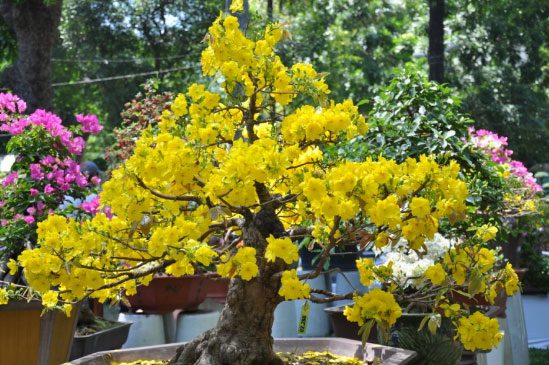
The Mai flower is highly cherished during Tet in Southern Vietnam.
Overview of the Mai Flower Tree
Basic Information About the Mai Flower Tree
The Mai flower tree belongs to the Ochnaceae family, scientifically named Ochna integerima, and is popularly known as the yellow Mai tree, highly favored during the traditional Tet holiday in Southern Vietnam.
In Vietnam, this species is most commonly found in the forests of the Truong Son mountain range and the provinces from Quang Nam and Da Nang to Khanh Hoa. The Mai flower is also present in the mountainous regions of the Mekong Delta, though in lesser quantities.
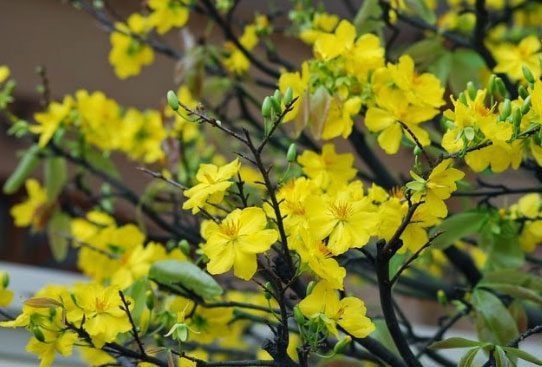
In nature, the Mai tree sheds its leaves in winter and blooms in spring.
The Mai tree is a perennial plant that can live for over a hundred years, with a thick and gnarled trunk, numerous branches, and alternate leaves. In nature, the Mai tree naturally sheds its leaves in winter and blooms in spring. Thus, our ancestors would prune the leaves in the lunar month of December to stimulate the flowering of the Mai tree during Tet.
Characteristics of the Mai Flower Tree
The Mai tree has a sturdy trunk, brittle branches, small leaves, and large, flat flowers that last a long time. Its appearance is elegant and graceful, with soft branches, gentle green leaves, and vibrant flowers.
Structure of the Mai Flower Tree
1. Roots of the Yellow Mai
The root system of the yellow Mai can penetrate 2 – 3 meters deep. The distribution of the roots depends on the soil properties, groundwater level where it is planted, propagation methods such as seed sowing, cutting, grafting, and the technical care conditions.
2. Trunk of the Yellow Mai
It is a large woody tree that can grow up to 20 – 30 meters high when allowed to grow freely, with a sparse canopy.
3. Leaves of the Yellow Mai
The leaves are simple, alternate, elongated oval-shaped, and the undersides have a slight yellow hue.
4. Flowers of the Yellow Mai
The flowers are bisexual and grow in clusters. The Mai flower typically blooms from the axil of the leaves, starting with a large flower known as the female flower, which is covered by a silk-like outer layer (husk).

Mai flowers typically grow from the axil of the leaves.
<pWhen the outer layer bursts open, a cluster of buds appears, ranging from one to ten buds, which grow very quickly, blooming within about seven days. Typically, the flowers bloom for three days before wilting. On the first day, the five petals and the stamen cluster spread beautifully. On the second day, the five petals lift up and the stamen cluster gathers. By the third day, the five petals begin to fall gently with the wind, signaling the flowers' demise.
5. Fruits of the Yellow Mai
After wilting, any flower that sets fruit will swell, forming seeds.
Origin and Significance of the Mai Flower
Origin of the Mai Flower
The Mai tree originates from China. According to the book “Treasure of Fragrant Flowers” by Phi Cong An from the Ming Dynasty, it is recorded that: “Dao Ky loved to admire the cold Mai, and Zhu Wang often wore snow while watching it.” This implies that over 3000 years ago, the Mai tree was present in China. The Chinese have had a long-standing affection for the Mai tree, considering it together with Pine and Chrysanthemum as part of the “Three Friends of Winter.” This signifies their resilience to cold and snow, akin to a gentleman’s steadfast character, able to endure adversity and never succumb to tyranny.
The Chinese have valued the Mai flower for a long time, considering it alongside the Pine and Chrysanthemum as part of the “Three Friends of Winter.” This signifies their resilience to cold and snow, akin to a gentleman’s steadfast character, able to endure adversity and never succumb to tyranny.

The Mai flower originates from wild trees and adapts well to tropical climates.
Adoring the Mai flower, the Chinese regard it as their national flower, just as the cherry blossom is for the Japanese. This may explain the elaborate names given to the Mai flowers. According to the book “Mai phổ”, the type of Mai flower with six round petals resembling daffodils is called “Daffodil Mai”, flowers that grow in pairs are known as “Mandarin Mai,” while those with red-pink petals are referred to as “Yen Chi Mai”, and those with dark green calyx are called “Luc Ngach Mai”, followed by “Hac Dinh Mai”, etc. However, they mainly fall into four main categories: White Mai (white as snow), Pink Mai (pink as blood), Yellow Mai (bright or deep yellow), and Black Mai (black or dark purple, which is not commonly cultivated).
The Mai tree originates from wild trees and is well adapted to tropical climates, especially in the southern region. The Mai tree grows vigorously, has a long lifespan, and with proper care, will produce many beautiful flowers. The Mai tree sheds its leaves once a year at the end of winter (January – February in the Gregorian calendar) and blooms at the beginning of spring, except for the Tu Quy Mai variety, which flowers year-round.
For a long time now, the Mai flower has been admired as a symbol of elegance and beauty. Whenever the Mai flowers bloom abundantly, it brings joy and excitement, marking the arrival of spring. The Mai flower and spring are inseparable symbols for the majority of ethnic groups residing in Asia. When spring is mentioned, it often conjures images of the New Year. Indeed, the absence of the Mai flower during Tet celebrations would be a significant omission that everyone acknowledges. For ages, the Mai flower has played an important role in Eastern literature, serving as inspiration for countless renowned figures.
Significance of the Mai Flower
In the North, there are peach blossoms, while in the South, we have the Mai flower. The yellow color of the Mai flower has long been seen as a symbol of wealth and prosperity. People display Mai flowers during Tet with the hope for a prosperous and wealthy new year. According to many beliefs, the more petals a house’s Mai flower has, the luckier and more prosperous that household will be in the new year.
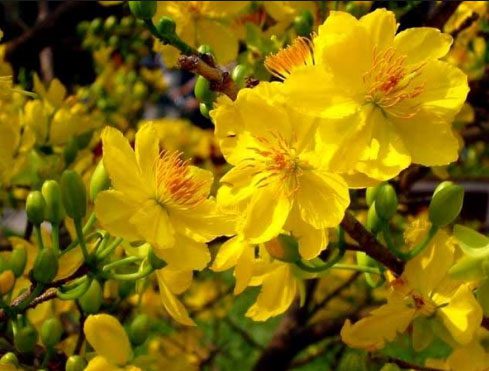
The Mai flower symbolizes the Vietnamese virtues of patience and noble sacrifice, and resilience.
The Mai tree has roots that delve deep into the earth, remaining unbowed by storms. It can withstand all types of weather, including harsh conditions. Thus, the Mai flower symbolizes the virtues of patience and noble sacrifice, and the resilience of the Vietnamese in general. Additionally, the Mai flower represents nobility and dignity.
The vibrant yellow Mai flowers in spring reflect joy, happiness, love, and the spirit of unity, bringing people together.
Now you understand the significance of the Mai and Peach flowers during Tet. Wishing you a joyful and warm Tet celebration with your family.
Classification of Mai Flowers in Vietnam
Classification Method 1
There are over 20 different types of Mai worldwide. In Vietnam alone, there are about 8 types, including: Bạch Mai, Hồng Mai, Hoàng Mai, Nhất Chi Mai, Mai Tứ Quý, Mai Chiếu Thủy, Song Mai.
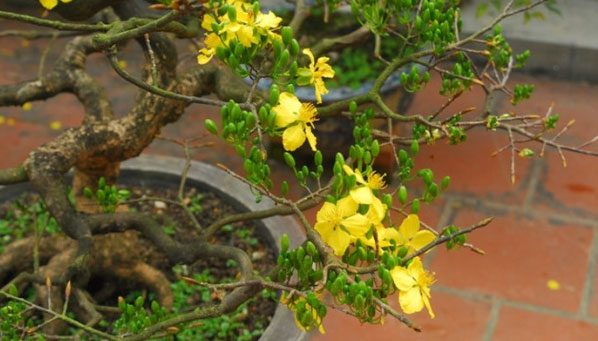
There are 8 types of Mai flowers in Vietnam.
- Song Mai: The flowers are pure white, blooming and bearing fruit in pairs, hence the name “Song Mai.”
- Mai Mơ: Also known as Hạnh Mai or the apricot tree, its scientific name is Prunus mume (Armeniaca mume), belonging to the Rosaceae family, with around 300 species. Mai Mơ trees can grow from 6 to 9 meters tall, with broad, oval leaves that have sharp tips and serrated edges. The flowers bloom in early spring, followed by leaf growth, with reddish-purple or dark green calyxes. The flowers typically have five petals in two colors: white and pink. The white Mai Mơ flowers are also known as Lục Ngạc Mai. The flowers develop into fruit, which is green when unripe and turns yellow when ripe. The fruit has a sweet and sour taste, with a lingering fragrance.
In the South, due to the tropical climate and proximity to the equator compared to the North, the Tet holiday always falls during hot weather. Therefore, various types of Mai can be found, such as Chiếu Thủy Mai, Nhất Chi Mai, Tứ Quý Mai, Bạch Mai, Hoàng Mai, Nam Mai, and a new type, the Burmese White Mai.
- Chiếu Thủy Mai: This is a perennial tree scientifically named Wrightia religiosa, growing to about 1.5 meters tall. The leaves are long and thin, growing in pairs. The small five-petaled flowers grow in tiny clusters, pure white, with a gentle, pleasant fragrance. The flower stalks always point downward, hence the name Chiếu Thủy Mai.
- Nhất Chi Mai: This flower is white with a hint of pink, commonly found in the South. The Nhất Chi Mai tree has a thick, rugged trunk and a glossy black bark. The leaves are small and light green, with pointed tips resembling the shape of a spearhead. Its flowers are smaller compared to other types, consisting of many thin petals that start off white and gradually turn red as they wither. Flowers can bloom singly or in clusters.
- Tứ Quý Mai: This type of Mai has five bright yellow petals, scientifically named Ochna astropurpurea. The flowers are not abundant but bloom naturally without the need for leaf shedding first. This flower is considered an ornamental type of Mai because it blooms year-round, hence the name Tứ Quý (meaning “four seasons”). It is also known as “Red Mai,” as when the yellow petals fall, the five calyxes turn dark red. The calyxes, instead of spreading out as before, wrap around the pistil, resembling a bud. The pistil inside develops seeds, changing from green when young to black when mature, expanding and making the five calyxes bloom again like a red Mai flower; for this reason, Tứ Quý Mai is also called Nhị Độ Mai (two-time blooming, first yellow, then red).
- Bạch Mai: This tree grows up to 15 meters tall, with a pleasant fragrance similar to Chiếu Thủy Mai. The Bạch Mai flowers resemble frangipani flowers, pure white symbolizing purity, with 6 to 8 large, thick, rounded petals and yellow pistils, giving off a delicate fragrance mixed with night dew, making it a rare flower. Bạch Mai is quite delicate and challenging to care for. It is commonly found in the Ba Den Mountain region of Tây Ninh and in Bến Tre and Hà Tiên.

Bạch Mai.
- Nam Mai: This is a type of white Mai widely found in the region known as “Nam Kỳ Lục Tỉnh,” specifically the Mù U tree. Its scientific name is Ochrocarpus samensis, belonging to the Guttiferae family (mangosteen). The Mù U tree is woody, with large, thick leaves the size of a person’s hand. The round fruit of the Mù U is the size of a thumb and is inedible. The seeds are pressed to make oil for lamps (producing lots of smoke, little light). The Mù U flowers are large and white with five petals, similar to Bạch Mai.
- Hoàng Mai: Known as the yellow Mai, it is also called Lạp Mai. The term “Lạp” refers to beeswax, likened to the bright golden color of the Mai flowers. Alternatively, “Lạp Nguyệt” refers to the month of December, so Lạp Mai is a type of Mai that only blooms once a year at the end of December (lunar calendar). In Vietnam, the area with the most yellow Mai is in the forests of the Trường Sơn mountain range, across provinces from Quảng Nam, Đà Nẵng to Khánh Hòa. There are also some in the highland provinces, albeit in lesser numbers.
- Hồng Mai: The scientific name of Hồng Mai is Jatropha pandurifolia, a woody plant that grows only about 1 to 4 cm tall. The leaves are dark green, growing singularly and lobed. The flowers of Hồng Mai have five petals, pink in color with bright yellow stamens. They grow in clusters at the branch tips and bloom sporadically throughout the year, not just in spring. The ripe fruit of Hồng Mai is brownish-black.
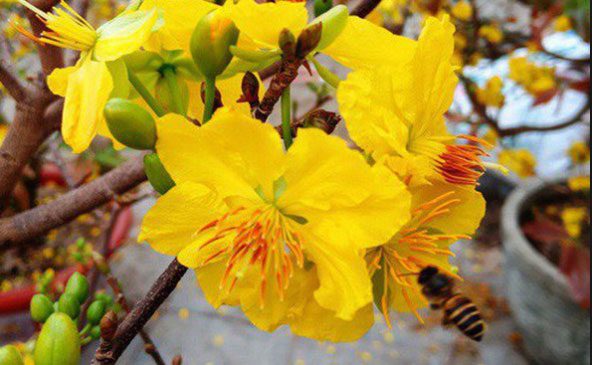
Mai Vàng.
- Yellow Mai that grows in forests is also known as Mai Núi. Mai Núi thrives in harsh conditions, competing for space with other trees, resulting in a uniquely beautiful appearance with many petals, ranging from 12 to 18 petals.
- Another type of yellow Mai found in sandy coastal forests is called Mai Động. The Mai Động tree is straight and round, with clusters of small flowers. Provinces from Quảng Bình, Quảng Trị extending to Đồng Nai, Tây Ninh have yellow Mai in abundance.
Classification Methods
1. Five-Petal Mai
This type of yellow Mai is commonly found in the Central region (from Đà Nẵng, Quảng Nam to Khánh Hòa) and in the ancient forests of the Trường Sơn mountain range. This is the natural five-petal Mai, with small flowers, moderately sized trunks, and fewer, more spaced-out blooms than some other types of Mai. However, if you wander into this Mai forest in spring, you’ll witness a brilliant golden hue covering the entire area, with fallen petals sometimes turning a stream golden as well. The fragrance fills and spreads across a vast region. In some mountains of the Mekong Delta, such as the Thất Sơn (Seven Mountains) area, this type can also be found, though in smaller and more scattered numbers.
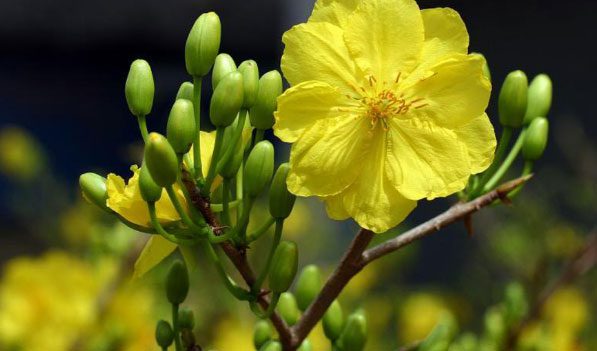 Mai 5 cánh phổ biến tại miền Trung và trên dãy Trường Sơn.
Mai 5 cánh phổ biến tại miền Trung và trên dãy Trường Sơn.
2. Mountain Mai
This is another type of forest Mai but with more petals ranging from 12 to over 18. This Mai grows on dry rocky mountains and primarily survives on dew, rainwater, and groundwater, along with the humid climate of the mountains. This type is commonly found in the mountainous areas of the Central Highlands and neighboring Cambodia.
3. Chủy Mai
This is also a type of forest Mai with very thick trunks, abundant flowers, and broad, glossy leaves with serrated edges. The flowers grow in beautiful clusters, hence the name Chủy (meaning “cluster” or “group”).
4. Động Mai, Sẻ Mai
This is a type of Mai that predominantly grows in sandy coastal areas. This Mai has a straight, round trunk and sparse blooming. If it has five petals, it is called Sẻ Mai; if it has more than five petals, it is known as Động Mai. Động Mai and Sẻ Mai are scattered across provinces from Quảng Bình, Quảng Trị extending to coastal regions in the Central area and can even be found in white sandy hills in the South, such as Tây Ninh, Đồng Nai, Biên Hòa, etc.
5. Chùm Gửi Mai, Tỳ Bà Mai, Vương Mai
This is a type of Mai that lives on other trees, especially large ancient trees. They cling to the tree trunks, partially absorbing nutrients from the soil and partially from the trees they attach to. Unlike other mistletoe types that only cling to other trunks, Chùm Gửi Mai relies half on its roots in the ground. Chùm Gửi Mai has a rough, hard trunk with bizarre growths. The buds and flowers emerge from these growths, blooming densely in tight clusters. In some areas, it is also called Tỳ Bà Mai or Vương Mai.
6. Hương Mai, Thơm Mai, or Ngự Mai
This is a type of yellow Mai with a very fragrant aroma, more fragrant than all other Mai types. Its scent is special and perhaps more intense than any other, which is why it is called Hương Mai, fitting its unique characteristics. In Bến Tre, many of these types exist, and locals refer to it affectionately as “Mai Thơm” because it is very fragrant, more so than the common types encountered in the Mekong Delta. In Huế, this type is also called “Mai Ngự” because it is grown in the royal palace and highly favored by the royal family, often given as high-quality gifts, hence the name “Mai Ngự.”
7. Mai Châu (Mai Trâu)
This type of Mai bears exceptionally large flowers, unusually large petals in bright yellow. Each flower can reach over 5 cm in diameter, which is why it is called Mai Trâu, often pronounced as “Mai Châu” in the Southern dialect.
8. Mai Liễu
This type of Mai has very soft, drooping branches like a willow tree, with few flowers. The leaves are sharp and small, elongated like willow leaves, hence the name Mai Liễu.
9. Mai Nhọn
This type of Mai has long, pointed leaves, with flower buds and petals having a similar shape.
10. Mai Cà Ná
This is a characteristic type that grows in the coastal region of Cà Ná in Ninh Thuận Province. This Mai has a small, weak trunk, with brittle and easily breakable branches, oval-shaped leaves, and smooth surfaces with serrated edges along the leaf margins. Locals refer to it as the Cà Ná forest Mai.
11. Mai Vĩnh Hảo
In the territory of Bình Thuận Province, specifically Tuy Phong District, Vĩnh Hảo Commune, where the most famous natural mineral water in Vietnam, “Vĩnh Hảo Mineral Water,” is located, there is another type of yellow Mai, characteristic of this area, which is quite similar to Mai Cà Ná. However, locals named it after the place it grows, calling it “Mai Vĩnh Hảo.” Mai Vĩnh Hảo has a sturdy trunk, small leaves, and large, flat flowers that last a long time without wilting.
12. Tứ Quý Mai
The distinctive species of apricot in the Southern region. This apricot also blooms with yellow flowers, but after the petals fall, the remaining flower calyx has five red petals with a stamen and three black seeds resembling beans. The five red petals are round and resemble a blooming apricot flower. Due to its nature of blooming twice on the same flower, it is also referred to as “Mai Tu Quy” or “Double Blooming Apricot.” This apricot blooms sporadically throughout the year, hence the name “Mai Tu Quy” (blooming in spring, summer, autumn, and winter). The trunk of the “Mai Tu Quy” is rough and black. Some trees grow very large and tall, but most are aged trees. The older they are, the more ancient and sturdy they appear.
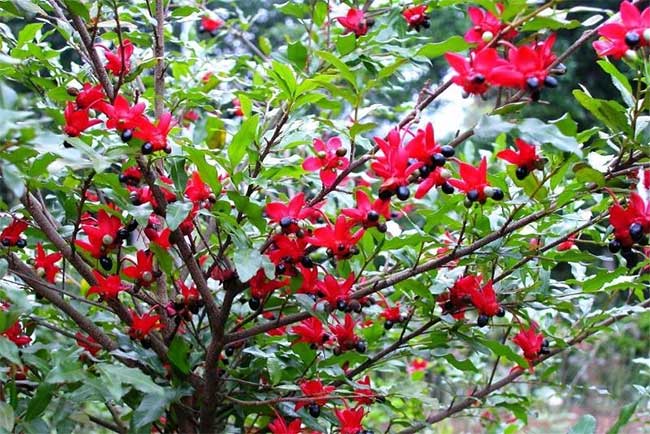
Mai Tu Quy.
13. Mai Giao
This type of apricot consists of many petals grafted from different types of apricots onto a single tree. Mai Giao takes the yellow apricot as the main base, then grafts branches of various other apricot types to create a variety of blossoms with numerous petals and colors on one tree. This is a man-made apricot variety that we see a lot in the Tet flower market today.
14. Mai Cuc
Mai Cuc is a woody plant with many branches and originates from Binh Dinh. The flowers can have many or few petals, and with good care, they can reach up to 150 petals.
15. Mai Xanh
Mai Xanh is known in English as Petrea Volubilis, a member of the apricot family, and is a popular plant originating from Central America and Mexico. It is a climbing plant with a rough, gray-brown stem, and the stem can grow up to 10 – 12 meters in length. There are two common varieties of Mai Xanh: Thai apricot and the green apricot from Da Lat.
Six Types of Apricot Worldwide
1. Cambodian Yellow Apricot (Mai Cao Mien)
The scientific name is Ochna integerrima. The apricot flowers have 5 to 9 petals, and when they bloom, they face downwards towards the flower stalk instead of spreading wide like Vietnamese apricot varieties; the flowers are pale yellow (almost dark orange). This type of apricot can also be found in Vietnam, mostly growing in forests in the Southern and Central regions. They are wild plants found in some hot sandy areas and along cool riverbanks. Cambodian yellow apricot is a woody plant with slender, long branches. The light green, glossy leaves grow sparsely on the branches, and the leaf edges are finely serrated. The flowers grow in clusters from leaf axils, with short flower stalks, and the calyx is shiny green and does not fully cover the buds. In Vietnam, this type is often used to graft into Mai Giao due to its ability to increase the number of petals significantly. Moreover, it currently has three colors from hybridization: red, yellow, and white.
2. South African Yellow Apricot
There are about 12 species of apricot in the Ochna genus, including both tree and shrub forms, with two common species being Ochna pretoriensis and Ochna pulchra. These species are found abundantly in the Koppie area. The Ochna pulchra can grow about 3 to 7 meters tall, and its bark often peels off, with easily shedding leaves. They grow wild in forests, with gray, rough bark at the base, and the branches have light cream-colored peeling bark. African apricot comes in two colors: yellow and pink. Additionally, South Africa has varieties very similar to the “Mai Tu Quy” in Vietnam.
3. Myanmar Yellow Apricot
In this Buddhist country, there is a type of apricot scientifically named Ochna serrulata, which is very similar to the South African apricot. However, the appearance of the apricot flower differs slightly in that the petals are flat or have a red ovary, similar to the “Mai Tu Quy,” and they can last a long time before completely falling off.
4. Indonesian Yellow Apricot
The scientific name is Ochna kirkii Oliv, Ochna serrulata. All of these species originate from Africa, but due to differing geological conditions, they have larger appearances than the African apricot. Some bloom in spring, summer, or even bloom throughout the four seasons like “Mai Tu Quy.”
5. Madagascar Yellow Apricot
This type of apricot has the scientific name Ochna greveanum, with five rounded petals, resembling the dumpling petal variety in Vietnam, and the leaves of the apricot are long and droop in clusters.
6. African Yellow Apricot
This is different from the South African yellow apricot as it resembles the five-petal yellow apricot of Vietnam but has a different scientific name, Ochna thomasiana. It is a shrub form with oval leaves, sharp tips, and lengths of about 10 cm. The flowers bloom on the branches in spring but sometimes unexpectedly bloom in summer, albeit in smaller quantities. The petals are elongated, about 2 cm long, the calyx spreads wide and turns a reddish-purple, with immature green fruits inside, similar to “Mai Tu Quy” in Vietnam.
These are 19 types of apricot from Vietnam and around the world, among which the 4th, 6th, and 7th types have seven different names according to the folk terminology in Vietnam. In total, there are 24 species of apricot worldwide, or possibly even more. Indeed, apricot flowers are very diverse and rich in variety. In China, they still refer to the peach tree as the apricot tree due to many types that closely resemble apricot flowers, especially the peach blossom and white peach, which they often call red apricot and white apricot. However, the apricot petals are round and small like peach petals, with thick and dense stamens, and the trunk is identical to the peach tree, hence they are often called peaches and not apricots.
During Tet, discussing the abundance of apricot trees allows us to learn about this iconic flower of spring. The apricot blossom is a symbol of luck, prosperity, and a perfect fresh start for the new year. The apricot flower also signifies the expulsion of negativity and misfortune, ensuring a year full of peace, smooth sailing, and prosperity.
The Uses of Apricot Flowers in Life
According to traditional medicine, apricot flowers are often used to treat ailments such as high fever, thirst, chest tightness, coughing, sore throat, burns, lymphatic tuberculosis, loss of appetite, dizziness, etc.
As Tet approaches and spring returns, despite the cold weather, apricot flowers still bloom, creating a white expanse like snow. In the highlands, apricot trees grow in forests, and during the blooming season, the white patches interspersed with the green of the mountains create a truly picturesque scene. Poets love apricot blossoms, and doctors also appreciate this flower.
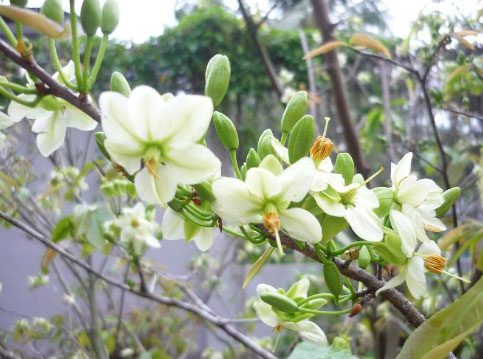
According to traditional medicine, apricot flowers have a sweet, slightly bitter taste, warm property, and are non-toxic…
The chemical composition of apricot flowers contains many essential oils such as cineole, borneol, linalool, benzyl alcohol, farnesol, terpineol, indole, and other substances like meratin, calycanthine, and carotene. Modern studies show that apricot flowers promote bile secretion and inhibit certain bacteria such as E. coli, dysentery bacillus, typhoid bacillus, cholera bacillus, and tuberculosis bacillus.
According to traditional medicine, apricot flowers have a sweet, slightly bitter taste, warm property, and are non-toxic. They are used to alleviate symptoms like high fever, thirst, chest tightness, coughing, sore throat, burns, lymphatic tuberculosis, loss of appetite, dizziness, etc. Ancient medical texts such as “Bản thảo cương mục,” “Bản thảo nguyên thủy,” “Bách thảo kính,” “Bản thảo tái tân,” “Cương mục thập di,” and “Thực vật nghi kỵ” have recorded many remedies using apricot flowers with insightful explanations. Specific examples can be cited as follows:
- Relief from Anxiety, Pain, and Dizziness: (1) 9g of Apricot Blossom boiled and consumed, or mix Apricot Blossom with Sea Bean Flower and fresh Lotus Leaves in adequate amounts, then boil and drink. (2) 15g of Apricot Blossom, 15g of White Chrysanthemum, and 15g of Rose, steeped and consumed as tea.
- High Blood Pressure, Angina Pectoris: 3g of Apricot Blossom and 10g of Cassia Seed steeped in boiling water in a sealed container, ready to drink after 15 minutes, consumed as tea throughout the day.
- Throat Obstruction, Stomach Pain, Mild Hepatitis and Cirrhosis: 5g of Apricot Blossom cooked with 100g of white rice into porridge, sweetened with white sugar, divided into several portions throughout the day. Throat obstruction is a condition where one feels something stuck in the throat causing blockage, unable to expel or swallow, but not affecting the ability to eat. For this condition, one can also use 12g of Apricot Blossom, 3g of Cinnamon, and 20g of tea, mixed evenly and steeped in three portions to drink as tea.
- Bloating and Flatulence: 10g of Apricot Blossom, 10g of Myrrh, and 15g of Cyperus, boiled and consumed.
- Abdominal Pain from Cold: Equal parts of Apricot Blossom and Cinnabar, dried and powdered, taken 3-6g with light alcohol each time.
- Hiccups: 5g of Apricot Blossom, 5 pieces of Hawthorn Fruit, 3 slices of fresh Ginger, and 100g of white rice. Boil the fresh Ginger and Hawthorn Fruit to extract the juice, discard the residue, then add the rice to make porridge. When cooked, add the Apricot Blossom, boil a few more times, and divide into several portions throughout the day.
- Nausea: 5g of Apricot Blossom and 5ml of fresh Ginger juice. Steep the Apricot Blossom in boiling water in a sealed container for about 20 minutes, strain, mix with fresh Ginger juice, and consume, using two servings daily.
- Acute Pharyngitis and Tonsillitis: (1) 6g of Apricot Blossom, 9g of Scrophularia, and 9g of Isatis, boiled and consumed. (2) 15g of Apricot Blossom, 15g of Honeysuckle, 15g of Gypsum, and 9g of Scrophularia, boiled and consumed. (3) 9g of Apricot Blossom steeped in boiling water in a sealed container, consumed as tea throughout the day.
- Chronic Pharyngitis: (1) 6g of Apricot Blossom, 5g of Gardenia, and 20g of tea. Mix and divide into two portions steeped in boiling water to drink as tea, one serving daily. (2) Apricot Blossom and 60g of white rice cooked into porridge, divided into several portions throughout the day, one serving daily.
- Persistent Cough: (1) 9g of Apricot Blossom steeped for tea throughout the day. (2) 10g of Apricot Blossom, 10g of Fritillaria, and 60g of white rice, all cooked into porridge, sweetened with a little honey, divided into several portions throughout the day.
- Severe Dehydration from Heat: 10g of Apricot Blossom, 10g of Ginseng Leaves, 10g of Licorice, 15g of Ophiopogon, and 6g of Patchouli, boiled and consumed.
- Loss of Appetite from Heat: 10g of Apricot Blossom and 50g of Lotus Leaves, steeped in boiling water and consumed as tea throughout the day.
- Chest Tightness and Shortness of Breath: 10g of Apricot Blossom, 10g of Salvia, and 15g of Chinese Schisandra, boiled and consumed throughout the day.
- Joint Pain from Rheumatism: 9g of Apricot Blossom, 9g of Dipsacus, and 9g of Corydalis, soaked in 200ml of alcohol, taken 30-50ml each time.
- Acute Conjunctivitis: 6g of Apricot Blossom and 9g of Chrysanthemum, boiled well and sweetened with a little honey for consumption.
- Injuries from Bruises: 9g of Apricot Blossom, 9g of Willow Leaves, and 9g of Gleditsia, soaked in 250ml of white alcohol, taken twice daily, 50ml each time.
- Bleeding Wounds: 10g of Apricot Blossom, roasted and powdered, sprinkled on the wound.
- Ulceration of Lips and Oral Mucosa: Fresh Apricot Blossom, mashed with white sugar, and the juice applied to the lesions.
- Lymphatic Tuberculosis: Adequate amounts of Apricot Blossom and one chicken egg. Use a sharp knife to make a small hole in the egg, insert the Apricot Blossom, steam until cooked, then consume, once a day for seven days.
- Skin Ulcers: 6g of Apricot Blossom soaked in peanut or sesame oil, used after two weeks, applied to the lesions twice daily.
- Burns: Adequate amounts of Apricot Blossom soaked in tea oil and applied to the burned area.
Additionally, in traditional cuisine, Apricot Blossom has been used by ancients as a food ingredient to create nutritious dishes alongside other foods such as pork, goat meat, sea cucumber, chicken eggs, carp, and shiitake mushrooms. Thus, with its elegant beauty and pure fragrance, the Apricot Blossom not only holds profound aesthetic value but also serves as an excellent medicinal herb and a unique food ingredient.
Techniques for Growing and Caring for Apricot Blossom
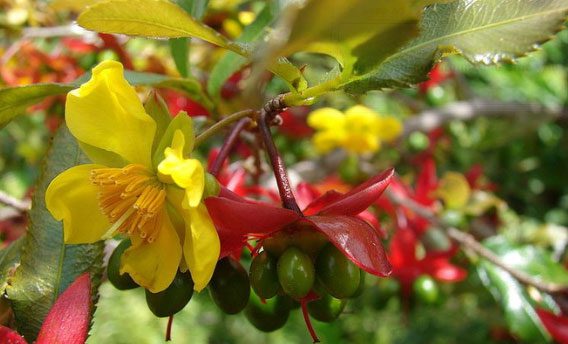
Applying the correct cultivation techniques will yield beautiful Apricot Blossoms.
- Soil for Planting Apricot Trees in Gardens: Apricot trees thrive well in light clay soil rich in organic matter, which is not acidic, and free from iron and salt contamination, or harmful chemicals.
- Soil for Planting Apricot Trees in Pots: Choose soil with the properties mentioned above, mixed in a ratio of about 70-80% soil and 20-30% decayed organic fertilizer by weight of the soil in the pot.
Apricot Trees Planted in Gardens
- Pruning: Growers should prune the apricot tree no later than the 20th day of the lunar month. Depending on the shape of the tree, enthusiasts should prune accordingly, but usually, the trees are pruned in a conical shape (short on top – long at the bottom). Generally, branches are cut back by one-third.
- Fertilization at Planting: Well-composted manure (from cattle and buffalo, rice husk ash, coconut fiber, etc.) about 5-10kg per root, lime powder about 200-300g per root + 50-100g of superphosphate. The total amount of fertilizer should be mixed evenly in the hole (or trench) before planting the seedlings.
- Topdressing: After about 10-15 days of planting, when the tree begins to produce new roots, use diluted NPK fertilizer 20-20-15+TE for watering, with a quantity of 50-100g per 10-15 liters of water, watering every 20-30 days. As the apricot tree matures, the amount of fertilizer also increases, and the intervals between applications are extended. The suitable soil fertilizer for apricot trees is NPK 20-20-15+TE or NPK 16-12-8-11+TE. The application rate is about 20-50g per root per application, every 1-2 months.
- When the Apricot Tree Flowers Consistently: Annually, it is necessary to supplement with 5-10kg of organic fertilizer per root. Use NPK 20-20-15+TE or NPK 16-12-8-11+TE, applying about 3-4 times a year with the same amount as mentioned during the periods: after flowering (after Tết), pruning; at the beginning of the rainy season; mid-rainy season; and one to one and a half months before the apricot blossoms. Fertilization should be done in holes or trenches about 5-7cm deep under the canopy of the tree, in areas with a lot of young roots, then cover with soil, keeping it moist in the dry season and allowing air circulation around the roots in the rainy season.
Apricot Trees Planted in Pots
Apricot trees should be placed outside as early as possible, in shaded areas to prevent leaf burn from direct sunlight. Growers need to remove all flowers to prevent the tree from losing nutrients necessary for seed development, leaving some leaves intact.
- Fertilization: The amount can vary from 20-50g per pot per application. For larger pots and older apricot trees, about 50-80g per pot can be applied. Create a trench around the pot, about 3-5cm deep, evenly distribute the fertilizer in the trench, cover with soil, and water sufficiently. Avoid cutting roots, as the tree can easily become infected through wounds. If conditions permit, at the beginning of the rainy season, replace the soil in the pot with fresh, loose soil, or add well-composted organic fertilizer, applying 2-3kg per pot.
- Using Foliar Fertilizers: Besides soil fertilizers, foliar fertilizers play an important role in promoting growth and development, supplementing nutrient deficiencies in the soil, and stimulating root, leaf, and flower production as desired by the grower.
Techniques for Growing and Caring for Apricot Blossoms for the New Year - Some foliar fertilizers of interest to gardeners include: Head Bull 501 to promote bud and leaf growth, Head Bull 701 to promote flowering, and Head Bull 901 which nourishes flowers, helping them last longer and have beautiful colors. Similar products like Head Bull 005, Head Bull 007, and Head Bull 009 also show high effectiveness for all ornamental apricot varieties.
As the spring season arrives, the light rain carrying the warmth of the new year begins to fall, marking the time when the yellow apricot blossoms display their beauty, signaling the arrival of spring. Peaceful spring, good fortune, and smiles adorn everyone’s faces, welcoming a new year of peace and happiness. While the North has peach blossoms, the South shines with the vibrant colors of apricot blossoms. The Apricot Blossom has become a symbol of the Tết holiday, heralding good fortune and positivity.




















































